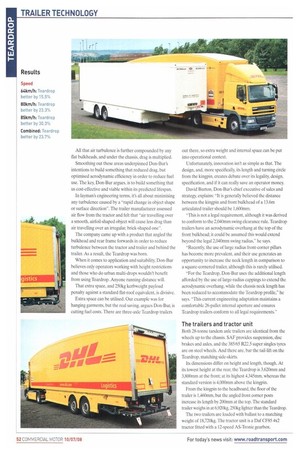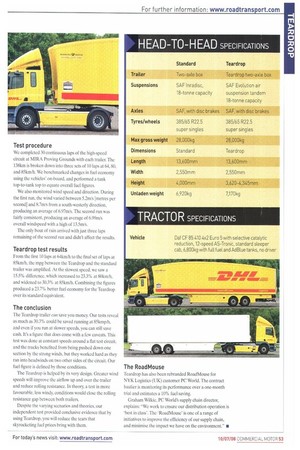All that air turbulence is further compounded by any flat bulkheads, and under the chassis, drag is multiplied.
Page 52

Page 53

If you've noticed an error in this article please click here to report it so we can fix it.
Smoothing out these areas underpinned Don-Bur's intentions to build something that reduced drag, but optimised aerodynamic efficiency in order to reduce fuel use. The key, Don-Bur argues, is to build something that us cost-effective and viable within its predicted lifespan.
In layman's engineering terms, it's all about minimising any turbulence caused by a "rapid change in object shape or surface direction". The trailer manufacturer assessed air flow from the tractor and felt that "air travelling over a smooth, airfoil-shaped object will cause less drag than air travelling over an irregular, brick-shaped one".
The company came up with a product that angled the bulkhead and rear frame forwards in order to reduce turbulence between the tractor and trailer and behind the trailer. As a result, the Teardrop was born.
When it comes to application and suitability, Don-Bur believes only operators working with height restrictions and those who do urban multi-drops wouldn't benefit from using Teardrop. Anyone running distance will.
That extra space, and 250kg kerbweight payload penalty against a standard flat-roof equivalent, is divisive.
Extra space can be utilised. Our example was for hanging garments, but the real saving, argues Don-Bur, is cutting fuel costs. There are three-axle Teardrop trailers out there, so extra weight and internal space can be put into operational context.
Unfortunately, innovation isn't as simple as that. The design, and, more specifically, its length and turning circle from the kingpin, creates debate over its legality, design, specification, and if it can really save an operator money.
David Burton, Don-Bur's chief executive of sales and strategy, explains: "It is generally believed the distance between the kingpin and front bulkhead of a 13.6m articulated trailer should be 1,600mm.
-This is not a legal requirement, although it was derived to conform to the 2,040mm swing clearance rule. Teardrop trailers have an aerodynamic overhang at the top of the front bulkhead; it could be assumed this would extend beyond the legal 2,040mrn swing radius," he says.
-Recently, the use of large radius front-corner pillars has become more prevalent, and their use generates an opportunity to increase the neck length in comparison to a square-cornered trailer, although this is rarely utilised.
"For the Teardrop, Don-Bur uses the additional length afforded by the use of large-radius cappings to extend the aerodynamic overhang, while the chassis neck length has been reduced to accommodate the Teardrop profile," he says. "This current engineering adaptation maintains a comfortable 26-pallet internal aperture and ensures Teardrop trailers conform to all legal requirements."
The trailers and tractor unit
Both 28-tonne tandem axle trailers are identical from the wheels up to the chassis. SAF provides suspension, disc brakes and axles, and the 385/65 R22.5 super singles tyres are on steel wheels. And there are, bar the tail-lift on the Teardrop, matching side-skirts.
Its dimensions differ on height and length, though. At its lowest height at the rear, the Teardrop is 3,620mm and 3,800mm at the front; at its highest 4,345mm, whereas the standard version is 4,000mrn above the kingpin.
From the kingpin to the headboard, the floor of the trailer is 1,460mm, but the angled front corner posts increase its length by 200nun at the top. The standard trailer weighs in at 6,920kg,250kg lighter than the Teardrop.
The two trailers are loaded with ballast to a matching weight of 18,720kg. The tractor unit is a Daf CF85 4x2 tractor fitted with a 12-speed AS-Tronic gearbox.
Test procedure
We completed 30 continuous laps of the high-speed circuit at MIRA Proving Grounds with each trailer. The 138km is broken down into three sets of 10 laps at 64.80, and 85km/h. We benchmarked changes in fuel economy using the vehicles on-board, and performed a tank top-to-tank top to equate overall fuel figures.
We also monitored wind speed and direction. During the first run, the wind varied between 5.2m/s [metres per second] and 8.7m/s from a south-westerly direction, producing an average of 6.97m/s. The second run was fairly consistent, producing an average of 6.99tn/s overall windspeed with a high of 13.5 m/s.
The only bout of rain arrived with just three laps remaining of the second run and didn't affect the results.
Teardrop test results
From the first 10 laps at 64km/h to the final set of laps at 85km/h, the mpg between the Teardrop and the standard trailer was amplified. At the slowest speed, we saw a 15.5% difference, which increased to 23.3% at 80km/h. and widened to 30.3% at 85km/h. Combining the figures produced a 23.7% better fuel economy for the Teardrop over its standard equivalent.
The conclusion
The Teardrop trailer can save you money. Our tests reveal as much as 30.3% could be saved running at 85kmpth, and even if you run at slower speeds, you can still save cash. It's a figure that does come with a few caveats. This test was done at constant speeds around a flat test circuit, and the trucks benefited from being pushed down one section by the strong winds, but they worked hard as they ran into headwinds on two other sides of the circuit. Our fuel figure is defined by those conditions.
The Teardrop is helped by its very design. Greater wind speeds will improve the airflow up and over the trailer and reduce rolling resistance. In theory, a test in more favourable, less windy, conditions would close the rolling resistance gap between both trailers.
Despite the varying scenarios and theories, our independent test provided conclusive evidence that by using Teardrop, you will reduce the tears that skyrocketing fuel prices bring with them.
The RoadMouse
Teardrop has also been rebranded RoadMouse for NYK Logistics (UK) customer PC World. The contract haulier is monitoring its performance over a one-month trial and estimates a 10% fuel saving.
Graham Wilkie, PC World's supply chain director, explains: -We work to ensure our distribution operation is 'best in class'. The 'RoadMouse' is one of a range of initiatives to improve the efficiency of our supply chain, and minimise the impact we have on the environment." •








































































































































































